Genre: Sports Developer: Rage Software Publisher: Sega Europe Players: 1-8 Released: 1993
Digging through my stash of games that saw an exclusive Mega Drive release only in Europe, I couldn’t help but notice that there were quite a lot of soccer games amongst this particular group of titles. Granted, in the early and mid-nineties soccer wasn’t very popular in the U.S., but it still strikes me as kind of odd that while almost every single American football game was also ported to Europe, there was apparently little effort made to bring any soccer title made in the old countries across the Atlantic.
Still, in Europe there was an abundance of soccer games available for any platform, and the Mega Drive was no exception. Most of the time, developers were struggling to give their game something extra, some unique selling point that made their game stand out from the competition, and you have to give England-based developer Rage some credit here. It definitely succeeded in that area, because Ultimate Soccer is rife with features that can hardly be found in any other soccer game out there. This particular one even has Sonic greeting you at the start of the game, as well as in the options menu! One feature stands out in particular, though: eight player mode! More on that later.
The first thing you’ll notice about the game are the settings, and by god are there a lot of them! You can select and adjust 18 different parameters, from the more usual ones like length of the game (2×1 minutes to 2×15) and condition of the pitch, to more unusual ones like strength (weak to strong) and direction of the wind. You can even choose whether you want to play a field match (with 11 players per team) or an indoors game (with walls instead of sidelines and only six players per team). Realism and options fetishists may feel in heaven; however, the more casual gamers may find that most of these menus are rather superfluous.
The different options don’t end with the settings menu, as you can also opt between a friendly exhibition match, preset tournament and league options, or set up a league or a tournament on your own. Before you start a match you pick the national team of your choice, each of which has three different strength bars ranging from one to 10. The game uses unlicensed characters and thus sports no real player names but rather made up ones. However, the developers snuck in the odd (if obscure) celebrity character into some of the national selections. Team Germany’s roster, for example, sports a forward named “O. Waalkes” (alluding to German comedian Otto Waalkes, a name regular readers may recognize from my Ottofants review). It’s also interesting to see that the developers decided to rank Japan amongst the strongest nations, making it an all-10 team (among many others like Germany, England, France, Italy, Brazil, the Netherlands… one might ask himself why the developers opted for a bar that ranges up to 10 when there are so many teams with identical ratings).
Which brings us to the gameplay. There are many schools and opinions on which perspective might be the best for a soccer game. Early titles had a slightly tilted side view of the pitch, but in the early nineties, most soccer games (like World Cup Italia ‘90, Sensible Soccer or Super Kick Off) preferred a top-down view, where you saw every player from straight above. Later on, the FIFA series would establish an isometric perspective. Ultimate Soccer foregoes any of these options, and Rage created a rather unique engine for the game. You have an angular view of the pitch – you play from the bottom of the pitch towards the top, and the camera follows the action not from straight above, but from a slanted perspective. If a player gets the ball and runs towards the top goal, you get to see him from behind. If the action turns the other way, the players face the camera. The angle can be set at two positions (somewhere above the shoulders and not quite bird’s eye view). The developers definitely succeeded in making the gameplay a rather unique experience, that’s for sure – the only other soccer games where you find that kind of point of view is in the Striker series, which basically are the sequels to this game created by the same development team.
Does it play well, though? Well, no, not quite. The problem with that perspective is that it’s very hard to properly account for distance – it’s a 2D game, after all. Whenever the ball goes high, it’s very hard to judge where it’ll come down, which turns passing more into a guessing game at first. You get used to this after a while, but the feeling that something’s off when kicking the ball high never quite goes away. It’s nice that the game lets you pick between two different perspectives, but the second option (with the camera higher and a steeper angle on the pitch) is even worse. The players are bigger than most of their contemporary counterparts in other games, but they aren’t nice to look at. The graphics look more like a Master System game, and there isn’t much detail or depth to them like you would expect from a 16-bit title, especially not one from 1993! The rather simplistic graphics don’t help the gameplay, So you never get quite the feeling that you’re in total control of the game.
Speaking of controls: The people at Rage also were early adopters of the six-button controller and decided to make use of every single button on it. So, you get little gimmicks like fast forward or rewind, and sending in a replacement player can also be accessed via the X-button. None of these options are vital to the gameplay, though. The regular maneuvers like passing, tackling or shooting the ball are all done with the regular A, B and C-buttons. However, there’s not much to these actions. The short pass with C is way too weak and hardly finds its target, while the far pass isn’t that much different from just kicking the ball on ahead. You’ll simply use the B-button for gameplay most of the time. Now if you have six buttons available but can easily win the can by utilizing a single one of them during the entire game, you can’t help but feel that there is some wasted effort in there.
The sound? It’s bad… really bad! There is only one piece of music that you hear in an endless loop when browsing the menus. The game itself is reduced to sound effects. I have the feeling that the programmers might not have had much experience with the sound capabilities of the console. When the players enter the pitch right before the kick-off, you hear the audience cheering, a sound that gets immediately cut off once the whistle blows and the first pass is played, never to return. Occasionally you hear a few weak, tinny beats that I think should resemble a drum being banged by some fans, but that’s all you hear from them. Throughout the entirety of the game, you otherwise only hear the weak thuds of a ball kicked, some grunts whenever a player gets fouled, and the referee’s whistle. You’ll hear that one a lot.
Why? Because the AI is somewhat broken. While you yourself can set your own team up in a more offensive or defensive manner (you can access your lineup via the pause menu and set up many different strategies there), it appears that once you manage to get ahead in a game, the AI switches to “aggressive defense.” In many games, this results in the computer players ruthlessly attacking and tackling your team. How bad can it get? Well, in one match lasting only 2×1 minutes, I was granted 15 free kicks and penalties! That’s one foul committed by the computer AI every eight seconds if you only count regular time! I desperately wanted to switch off penalties because I got incredibly annoyed about the abundance of fouls the computer made, but interestingly enough, amongst the multitude of settings you can adjust, this one is missing. Other than that, the AI isn’t particularly clever either, even in the highest difficulty the best teams can easily be outmaneuvered with the same tactics over and over after a little practice.
Still, a soccer game with bad AI can still be salvaged if multi-player is fun, even if the gameplay engine is kind of wonky. Here’s where the “ultimate” in Ultimate Soccer is kind of justified because there is no other soccer game on the Genesis that actually has an eight-player mode. This one does, if you connect two Sega Taps to the console and switch them to “extra.” The way the game handles multi-player matches is rather odd, though. While most games allow to switch to the players nearest to the ball with the press of a button, Ultimate Soccer doesn’t. Instead, whenever more than one player wants to join in, the game wants each player to permanently select his character(s) in the team. In some way it resembles the days of backyard games. If you are a weak player and the others don’t like you, you get stuck playing the goalie for the entire game, while someone else gets to pick a forward AND a midfield player. Needless to say, it sucks. You can’t evenly split up every character in two teams (either 22 or 12 depending on which mode you play) amongst eight players, and if one gets stuck playing only defense or forwards, it can get hopelessly chaotic if you opted to play on the big pitch. Eight player mode on the big pitch is a mess, and it’s only understandable that the developers dropped that option from their subsequent games and only stuck to a two-player mode when the sequel Striker came to be.
One must give credit where it’s due, though. The indoor games are fun! It’s an option not found in many other soccer games. Since the pitch is smaller and there are no sidelines, the gameplay is refreshingly fast-paced, especially when compared to the other mode of play. And because the teams are smaller as well, the distribution of the individual characters among each player is a little fairer, so everyone can more sensibly join in on the action. So if you want to try eight player mode, stick to the indoor games, where everyone gets to play exactly one character on the field (though someone gets to pick a second one as well).
Ultimate Soccer definitely tries a lot to make itself stand out in the field, and it certainly has some memorable features. None of them are particularly polished or well-executed, though. Eight player mode is a nice idea, but it just isn’t a satisfying experience. The gameplay isn’t all that bad, but it isn’t all that good either. The sound effects are awful, and the graphics are more akin to an 8-bit console. The only saving grace is the indoor mode, which is a refreshing change of pace and both a unique inclusion and a fun experience in multiplayer mode. If you want to give that a try though I strongly suggest that you pick up the sequel Striker instead and leave that one in the bargain bin.
SCORE: 4 out of 10

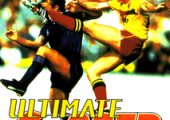
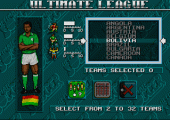
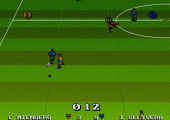
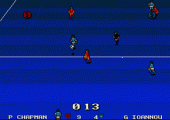
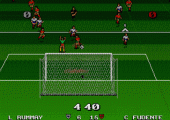
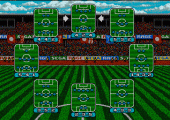
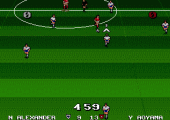
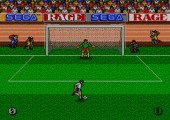
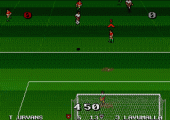
Recent Comments